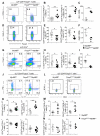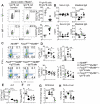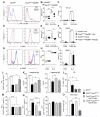MyD88 Adaptor-Dependent Microbial Sensing by Regulatory T Cells Promotes Mucosal Tolerance and Enforces Commensalism
- PMID: 26231118
- PMCID: PMC4545404
- DOI: 10.1016/j.immuni.2015.06.014
MyD88 Adaptor-Dependent Microbial Sensing by Regulatory T Cells Promotes Mucosal Tolerance and Enforces Commensalism
Abstract
Commensal microbiota promote mucosal tolerance in part by engaging regulatory T (Treg) cells via Toll-like receptors (TLRs). We report that Treg-cell-specific deletion of the TLR adaptor MyD88 resulted in deficiency of intestinal Treg cells, a reciprocal increase in T helper 17 (Th17) cells and heightened interleukin-17 (IL-17)-dependent inflammation in experimental colitis. It also precipitated dysbiosis with overgrowth of segmented filamentous bacteria (SFB) and increased microbial loads in deep tissues. The Th17 cell dysregulation and bacterial dysbiosis were linked to impaired anti-microbial intestinal IgA responses, related to defective MyD88 adaptor- and Stat3 transcription factor-dependent T follicular regulatory and helper cell differentiation in the Peyer's patches. These findings establish an essential role for MyD88-dependent microbial sensing by Treg cells in enforcing mucosal tolerance and maintaining commensalism by promoting intestinal Treg cell formation and anti-commensal IgA responses.
Copyright © 2015 Elsevier Inc. All rights reserved.
Figures







Similar articles
-
Segmented filamentous bacterium uses secondary and tertiary lymphoid tissues to induce gut IgA and specific T helper 17 cell responses.Immunity. 2014 Apr 17;40(4):608-20. doi: 10.1016/j.immuni.2014.03.009. Immunity. 2014. PMID: 24745335
-
c-Maf-dependent Treg cell control of intestinal TH17 cells and IgA establishes host-microbiota homeostasis.Nat Immunol. 2019 Apr;20(4):471-481. doi: 10.1038/s41590-019-0316-2. Epub 2019 Feb 18. Nat Immunol. 2019. PMID: 30778241
-
The continuum of intestinal CD4+ T cell adaptations in host-microbial mutualism.Gut Microbes. 2011 Nov-Dec;2(6):353-7. doi: 10.4161/gmic.18604. Epub 2011 Nov 1. Gut Microbes. 2011. PMID: 22157235
-
The balance of intestinal Foxp3+ regulatory T cells and Th17 cells and its biological significance.Expert Rev Clin Immunol. 2014 Mar;10(3):353-62. doi: 10.1586/1744666X.2014.882232. Epub 2014 Feb 3. Expert Rev Clin Immunol. 2014. PMID: 24483245 Review.
-
Regulation of Th17 cell differentiation by intestinal commensal bacteria.Benef Microbes. 2010 Nov;1(4):327-34. doi: 10.3920/BM2010.0026. Benef Microbes. 2010. PMID: 21831771 Review.
Cited by
-
Early life microbial exposures and allergy risks: opportunities for prevention.Nat Rev Immunol. 2021 Mar;21(3):177-191. doi: 10.1038/s41577-020-00420-y. Epub 2020 Sep 11. Nat Rev Immunol. 2021. PMID: 32918062 Review.
-
Immunology: You Remind Me of a Microbe I Know.Curr Biol. 2016 May 9;26(9):R373-6. doi: 10.1016/j.cub.2016.03.064. Curr Biol. 2016. PMID: 27166699 Free PMC article.
-
Foxp3 and Toll-like receptor signaling balance Treg cell anabolic metabolism for suppression.Nat Immunol. 2016 Dec;17(12):1459-1466. doi: 10.1038/ni.3577. Epub 2016 Oct 3. Nat Immunol. 2016. PMID: 27695003 Free PMC article.
-
Bacterial extracellular vesicles at the interface of gut microbiota and immunity.Gut Microbes. 2024 Jan-Dec;16(1):2396494. doi: 10.1080/19490976.2024.2396494. Epub 2024 Sep 28. Gut Microbes. 2024. PMID: 39340209 Free PMC article. Review.
-
Mechanisms of Oral Tolerance.Clin Rev Allergy Immunol. 2018 Oct;55(2):107-117. doi: 10.1007/s12016-018-8680-5. Clin Rev Allergy Immunol. 2018. PMID: 29488131 Free PMC article. Review.
References
-
- Backhed F, Ley RE, Sonnenburg JL, Peterson DA, Gordon JI. Host-bacterial mutualism in the human intestine. Science. 2005;307:1915–1920. - PubMed
Publication types
MeSH terms
Substances
Grants and funding
LinkOut - more resources
Full Text Sources
Other Literature Sources
Medical
Molecular Biology Databases
Miscellaneous

